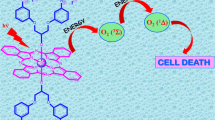Abstract
Water-soluble supramolecular complexes of aluminum phthalocyanines with rare photoactive nano-aggregates were developed on the basis of mesoporous silica nanoparticles (AlCl-Pc-nSiO2) and polyvinylpyrrolidone (AlCl-Pc-PVP). Radiative lifetimes, extinction coefficients, and electron transition energies were calculated for isolated and associated metal phthalocyanine complexes. Nontoxic concentrations were determined for the synthetic nanocomposite photosensitizers in vitro. The photodynamic treatment efficacy was compared for three aluminum phthalocyanine modifications: Photosens®, AlCl-Pc-nSiO2, and AlCl-Pc-PVP. Mesenchymal stromal cells were used as a model for photodynamic treatment. The most efficient intracellular accumulation was observed for AlCl-Pc-nSiO2. Illumination of phthalocyanine-loaded cells led to a generation of reactive oxygen species and subsequent apoptotic cell death. Silica nanoparticles provided for a significant decrease in effective phthalocyanine concentration and enhanced cytotoxicity of photodynamic treatment.
Similar content being viewed by others
Abbreviations
- MPc:
-
metal phthalocyanine complex
- PDT:
-
photodynamic treatment
- PVP:
-
polyvinylpyrrolidone
- nSiO2 :
-
silica nanoparticles
- MMSC:
-
multipotent mesenchymal stromal cell
- AlCl-Pc:
-
aluminum chloride phthalocyanine
- AlCl-Pc-nSiO2 :
-
AlCl-Pc supramolecular complexes based on nSiO2
- AlCl-Pc-PVP:
-
AlCl-Pc supramolecular complexes based on PVP
- LUMO:
-
lowest unoccupied molecular orbital
- HOMO:
-
highest occupied molecular orbital
References
G. N. Kamau and J. F. Rusling, Langmuir 12(11), 2645 (1996).
E. A. Lukyanets and V. N. Nemykin, J. Porphyrins Phthalocyanines 14, 1 (2010).
G. de la Torre, P. Vázquez, F. Agulló-López, and T. Torres, Chem. Rev. 104(9), 3723 (2004).
W.-S. Li and T. Aida, Chem. Rev. 109(11), 6047 (2009).
A. P. Castano, T. N. Demidova, and M. R. Hamblin, Photodiag. Photodynam. Ther. 1, 279 (2004).
M. L. Gelfond, Prakt. Onkol. 8(4), 204 (2007).
D. Wohrle, A. Wendt, F. Weitemeyer, et al., Izv. Akad. Nauk, Ser. Khim. 12, 2071 (1994).
G. Bertoloni, F. Rossi, G. Valduqa, et al., Microbios. 71(286), 33 (1992).
E. Reddi, C. Zhou, R. Biolo, et al., Br. J. Cancer 61, 407 (1990).
C. F. van Nostrum, Adv. Drug Deliv. Rev. 56, 9 (2004).
I. Roy, T. Y. Ohulchanskyy, H. E. Pudavar, et al., J. Am. Chem. Soc. 125, 7860 (2003).
N. Bailly, M. Thomas, and B. Klumperman, Biomacromolecules 13, 4109 (2012).
Y. Piao, A. Burns, J. Kim, et al., Adv. Funct. Mater. 18, 3745 (2008).
J. Tu, T. Wang, and W. Shi, Biomaterials 33, 7903 (2012).
P. Couleaud, V. Morosini, C. Frochot, et al., Nanoscale 2, 1083 (2010).
X. Liu, Y. Xu, Z. Wu, and H. Chen, Macromol. Biosci. 13, 147 (2013).
J. Stagg, Stem Cell Rev. 4, 119 (2008).
A. B. Mohseny and P. C. Hogendoorn, Stem Cells 29, 397 (2011).
M. Ya. Mel’nikov, E. G. Bagryanskaya, Yu. A. Vainshtein, et al., Experimental Methods in High-Energy Chemistry, Ed. by M.Ya Mel’nikov (Mosk. Gos. Univ., Moscow, 2009) [in Russian].
P. A. Zuk, M. Zhu, P. Ashjian, et al., Mol. Biol. Cell. 13, 4279 (2002).
L. B. Buravkova, O. V. Grigorieva, E. R. Andreeva, et al., Bull. Exp. Biol. Med. 151(3), 344 (2011).
S. T. Smiley, M. Reers, C. Mottola-Hartshorn, et al., Proc. Natl. Acad. Sci. U. S. A. 88(9): 3671 (1991).
M. Reers, S. T. Smiley, C. Mottola-Hartshorn, et al., Methods Enzymol. 260: 406 (1995).
F. Di Lisa, P. S. Blank, R. Colonna, et al., J. Physiol. 486, 1 (1995).
C. Cottet-Rousselle, X. Ronot, X. Leverne, et al., Cytometry 79(6), 405 (2011).
B. W. Veun and S. T. Stern, Methods Mol. Biol. 697, 207 (2011).
T. Mosmann, J. Immunol. Methods 65(1–2), 55 (1983).
H. Cen, F. Mao, I. Aronchik, et al., FASEB J. 22(7), 2243 (2008).
O. O. Udartseva, E. R. Andreeva, and L. B. Buravkova, Dokl. Biol. Sci. 450, 185 (2013).
Author information
Authors and Affiliations
Corresponding author
Additional information
Original Russian Text © O.O. Udartseva, A.V. Lobanov, E.R. Andreeva, G.S. Dmitrieva, M.Ya. Mel’nikov, L.B. Buravkova, 2014, published in Biofizika, 2014, Vol. 59, No. 6, pp. 1051–1060.
Rights and permissions
About this article
Cite this article
Udartseva, O.O., Lobanov, A.V., Andreeva, E.R. et al. Photophysical properties and photodynamic activity of nanostructured aluminum phthalocyanines. BIOPHYSICS 59, 854–860 (2014). https://doi.org/10.1134/S0006350914060244
Received:
Accepted:
Published:
Issue Date:
DOI: https://doi.org/10.1134/S0006350914060244




